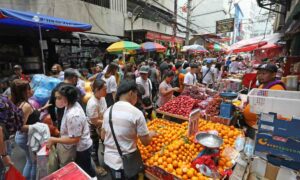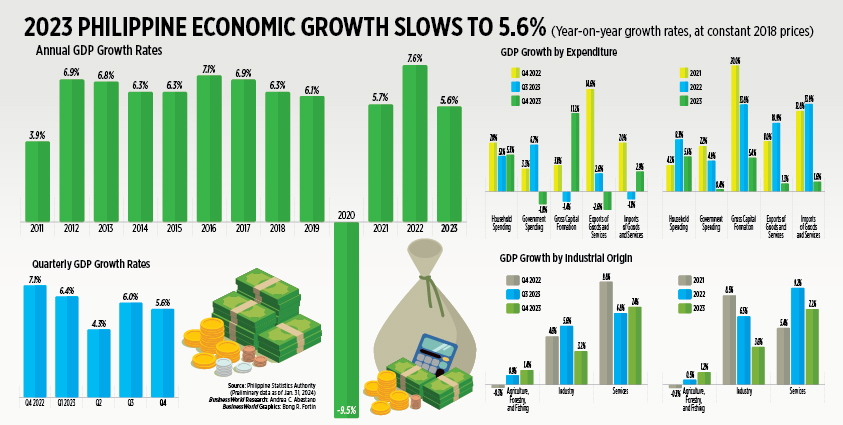




Policy Rate Updates: Double cut finale
 DOWNLOAD
DOWNLOAD

Monthly Economic Update: One for the road
 DOWNLOAD
DOWNLOAD

Inflation Update: Still low, still slow
 DOWNLOAD
DOWNLOAD


GDP grows 5.6%, falls short of target

THE Philippine economy grew by 5.6% in 2023, falling short of the government’s full-year target as state spending and exports declined and high interest rates dampened consumption.
Data from the Philippine Statistics Authority (PSA) showed that gross domestic product (GDP) in 2023 was much slower than the 7.6% expansion in 2022.
However, the full-year GDP was higher than the median 5.5% growth estimate in a BusinessWorld poll of 20 economists last week.
“While this growth is below our target of 6-7% for this year, this keeps us in the position of being one of the best-performing economies in Asia,” National Economic and Development Authority (NEDA) Secretary Arsenio M. Balisacan said.
In the fourth quarter, GDP expanded by 5.6%, slower than the revised 6% GDP growth in the third quarter and the 7.1% expansion in the fourth quarter of 2022. It was also below market expectations, based on a BusinessWorld poll that yielded a 5.7% estimate.
Mr. Balisacan earlier said the economy would had to grow by at least 7.2% in the fourth quarter to meet the lower end of the government’s 6-7% target.
Among Asian countries with available data, the Philippines’ fourth-quarter growth was also just behind Vietnam (6.7%) and ahead of China (5.2%) and Malaysia (3.4%).
On a seasonally adjusted quarterly basis, Philippine GDP grew by 2.1% in the fourth quarter, slower than 3.8% a quarter earlier.
Mr. Balisacan said that economic growth could have been faster if not for the impact of elevated inflation and high interest rates last year.
Inflation averaged 6% in 2023, marking the second straight year that it breached the Bangko Sentral ng Pilipinas’ (BSP) 2-4% target range.
“Expectedly you would have achieved higher growth if inflation was not that high,” he said.
To tame inflation, the Monetary Board hiked borrowing costs by a total of 450 basis points (bps) from May 2022 to October 2023, bringing the key rate to a 16-year high of 6.5%.
“The long-term effects of these (tightening), you will feel it a few quarters down the line. This slowing down that we are seeing is possibly the effect of past increases in interest rates early last year and even in 2022,’’ Mr. Balisacan added.
GOV’T SPENDING DOWN
Data from the PSA also showed that government spending contracted by 1.8% in the fourth quarter, a reversal of the 6.7% growth in the previous quarter and 3.3% a year ago.
For the full year, government spending posted flat growth of 0.4%, slower than the 4.9% in 2022.
Mr. Balisacan said that slower state spending was due to the government’s fiscal consolidation plan.
“It was intentional that the growth in government spending was not too high in 2023 because we want to achieve fiscal consolidation. That means lowering the fiscal deficit and government debt but still be able to provide enough for social protection,” he added.
Government spending contracted by 7.1% in the second quarter, hurting growth and prompting the Finance and Budget departments to order agencies to accelerate spending and improve budget use.
Meanwhile, household final consumption jumped by 5.3% in the fourth quarter, faster than 5.1% in the previous quarter but slower than 7% a year earlier.
In 2023, household spending expanded by 5.6%, much slower than 8.3% in 2022. Private consumption accounts for about three-fourths of the economy.
The top contributors to fourth-quarter consumption were restaurants and hotels (16.2%), transport (12.2%) and recreation (7.3%). On the other hand, spending on clothing and footwear declined by 1.4%.
Mr. Balisacan said the data reflect an improvement in the jobs market and sustained growth in remittances.
“However, we are concerned about the low growth in food spending due to high food prices, though inflation has moderated in recent months,” he added.
The NEDA chief said the government would “relentlessly manage” inflation by strengthening agricultural value chains, using trade policies to support production and prevent anti-competitive practices.
Gross capital formation — the investment component of the economy — jumped by 11.2% in the October-December period, faster than 3.3% a year ago. This was also a turnaround from the 1.4% decline in the third quarter.
“The robust investment expansion during the quarter was driven by significant growth in fixed capital (10.2%), particularly the expansion of durable equipment (14.6%),” Mr. Balisacan said.
For the full year, gross capital formation rose by 5.4%, slower than 13.8% d a year ago.
Exports of goods and services shrank by 2.6% in the fourth quarter, a reversal of the 2.6% growth in the previous quarter and 14.6% expansion a year earlier. This brought the full-year growth to 1.3%, slower than 10.9% in 2022.
“The weak global economy weighed heavily on our export sector… The decline came mainly from the deep contraction in goods exports (11.6%), although service exports grew by 12.3%,” Mr. Balisacan said.
“We expect the growth in services to maintain its trajectory as international tourism rebounds,” he added.
Meanwhile, imports grew by 2.9% in the fourth quarter, a turnaround from the 1.1% contraction in the third quarter. However, it was slower than the 7% expansion in the previous year.
Imports expanded by 1.6% in 2023, slower than 13.9% in the previous year.
Net primary income from the rest of the world surged by 97.7% in the fourth quarter, faster than 59.9% a year ago.
The full-year figure jumped by 96.6%, faster than 77.3% a year earlier.
Gross national income (GNI) — the sum of the country’s GDP and net income received from overseas — rose by 11.1% in the fourth quarter, higher than 9.3% a year ago. For 2023, GNI grew by 10.5%, quicker than 9.9% in 2022.
On the production side, all sectors registered growth. Service expanded by 7.4% in the October-to-December period, slowing from 9.8% in 2022. Services growth eased to 7.2% in 2023 from 9.2% in 2022.
Industry grew by 3.2% last quarter, slower than 4.6% a year earlier. This brought full-year industry growth to 3.6%, much weaker than 6.5% a year ago.
Agriculture, forestry and fishing growth inched up to 1.4% in the October-December period, a turnaround from the 0.3% contraction in the previous year. In 2023, the sector posted growth of 1.2%, better than 0.5% in 2022.
‘WORK HARDER’
Despite missing the 2023 growth goal, the NEDA chief said he is still confident about meeting the 6.5-7.5% GDP growth target this year. The Development Budget Coordination Committee (DBCC) is expected to meet soon to reassess its macroeconomic assumptions.
“I don’t think (we) are giving up this early, it is only the first (month) of the year and now you want to say reduce the 6.5%, that is too defeatist,” Mr. Balisacan said.
He said the government should work harder to meet its growth goals and monitor risks such as El Niño and geopolitical tensions.
Capital Economics Emerging Asia economist Shivaan Tandon said private consumption might remain muted this year.
“GDP growth remained well above trend in the fourth quarter, but we don’t expect this strength to last as the deceleration in credit growth feeds through to weaker growth in domestic demand over the coming quarters and the external sector continues to struggle,” he said in a note.
ANZ Research economist Debalika Sarkar and Chief Economist Sanjay Mathur in a note said they kept their GDP growth projection at 5.6% this year.
“Private consumption should settle at the 2023 pace amid stabilizing employment and income growth. Overall fiscal support should moderate with the 2024 budget deficit projected to decline to 5.1% of GDP from an estimated 6.1% in 2023. These should be partially offset by a modest improvement in exports,” they added.
Metrobank Research in a bulletin said it sees growth averaging 6% this year “on the back of decelerating inflation and interest rate cuts.”
“The Philippines appears relatively insulated from external shocks, i.e., geopolitical risks, as the sources of growth continue to be largely from domestic consumption and services as well as the bright spots seen in the recovery of tourism, overseas Filipino workers’ remittances, and business process outsourcing revenues,” it said.
HSBC Global Research economist Aris Dacanay said he expects growth to settle at 5.3% this year, but noted risks are tilted to the upside.
Meanwhile, Manulife Investment Management Philippines Head of Equities Mark Canizares said in a commentary that they are optimistic about growth prospects this year.
“We have a positive outlook for the Philippine economy based on the improving macroeconomic picture. The decline in inflation back to BSP’s target of 2-4% could open up the possibility of easing rate policy and boosting economic growth this 2024,” he said.
However, Mr. Canizares flagged risks such as supply shocks that could come from El Niño, geopolitical tensions and a global economic slowdown. – Luisa Maria Jacinta C. Jocson, Reporter
This article originally appeared on bworldonline.com





 By BusinessWorld
By BusinessWorld
